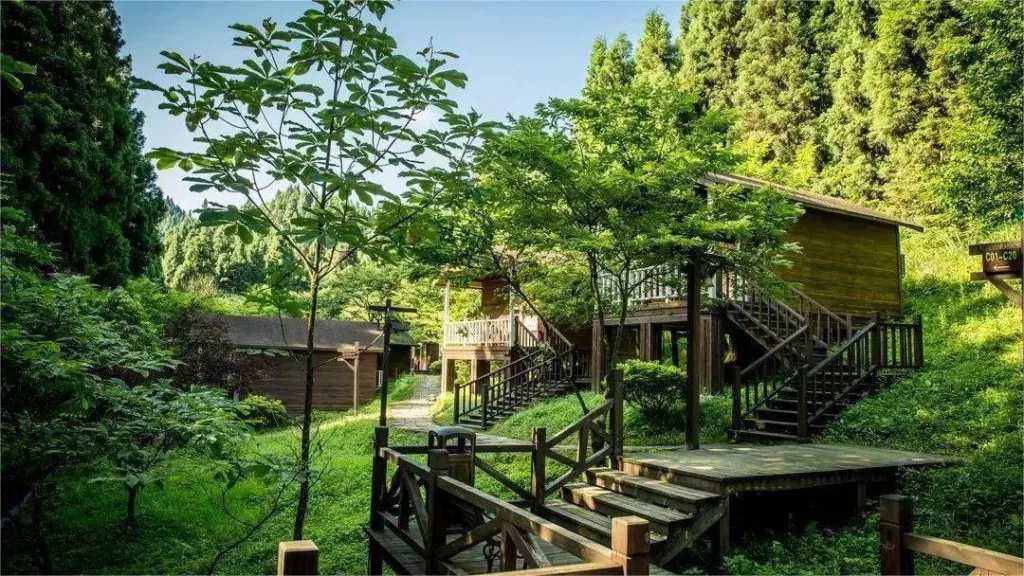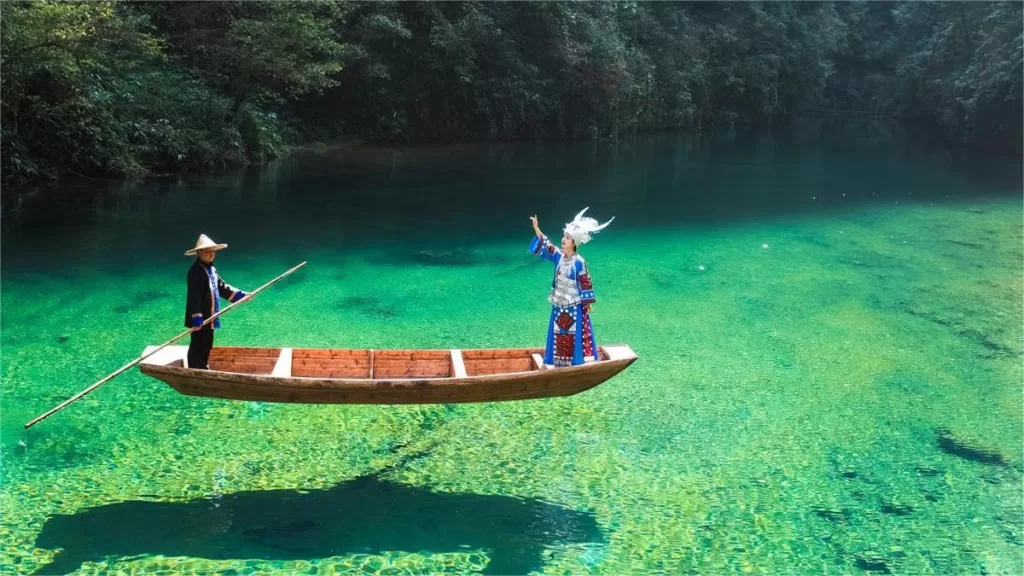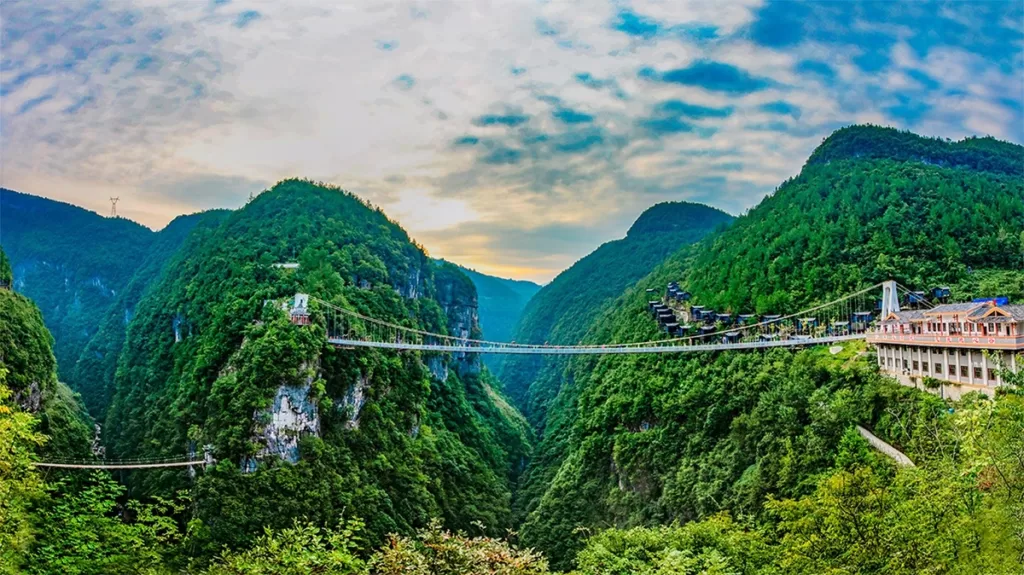Shennong Stream (神农溪), originating from the main peak of Shennongjia, flows eastward to join the Yangtze River at Wuxia Gorge. This picturesque watercourse is a quintessential canyon stream, characterized by towering peaks tightly embracing its path. The stream, formerly known as Yangdu River, earned its current name, Shennong Stream, due to a legend that traces back to the mythical figure Shennong, a legendary emperor and herbalist, who is said to have descended the stream after constructing a framework for medicinal herbs. The entire stream comprises three main gorges – Longchang Gorge, Yingwu Gorge, and Shennong Gorge – along with a tributary called Mianzhu Gorge.
Shennong Stream weaves through a dramatic landscape, with steep cliffs and turbulent waters cascading through a series of more than sixty rapids, including perilous shoals, lengthy sandbanks, winding bends, and shallow stretches. Despite its narrow and swift watercourse, the stream maintains a remarkable clarity.
To embark on an exploration of Shennong Stream, visitors typically board boats at the riverside pier in Badong County along the Yangtze River. The round trip takes approximately four hours, allowing travelers to marvel at the breathtaking scenery of the three gorges and the enchanting Mianzhu Gorge. Shennong Stream stands as a testament to nature’s raw beauty, inviting adventurers to immerse themselves in its rich cultural and geological tapestry.
Table of Contents
- Basic Information
- Location and Transportation
- Highlights of Shennong Stream
- Vlog about Shennong Stream
- Other Attractions in Enshi Suburbs
Basic Information
| Estimated Length of Tour | 4 hours |
| Ticket Price | Boat Cruise: 120 RMB Raft Drifting: 105 RMB Must book 24 hours in advance |
| Opening Hours | 8.00 – 16.00 |
| Telephone Number | 0086-0718-4330000 |
Location and Transportation
Shennong Stream originates from the main peak of Shennongjia, flowing through the mountainous terrain within the boundaries of Badong County in Hubei Province, China. It courses from north to south, weaving through deep mountain gorges, and ultimately converges with the Yangtze River to the east of Wuxia Gorge. The entrance to explore Shennong Stream is located within Badong County, part of the Enshi Tujia and Miao Autonomous Prefecture in Hubei.
Travelers can reach Shennong Stream by first taking a flight or train to Enshi. From there, they can transfer to a tourist shuttle bus that directly leads to Shennong Stream, providing a convenient and direct route to this natural wonder.
Highlights of Shennong Stream
Mianzhu Gorge

Mianzhu Gorge, nestled within the enchanting landscape of Shennong Stream, stands out for its peculiar and treacherous beauty. Renowned for its challenging terrain, the gorge boasts a lush and profound scenery, representing a rare relic of ancient geological movements. The canyon is characterized by the juxtaposition of towering peaks and rocks, with distinct layers forming sheer cliffs that reach a staggering thousand meters in height. At the mountain summits, numerous caves dot the landscape, believed to be remnants of dwellings used by the early Tujia people. Many of these caves bear traces of collapsed walls or small stone constructions on the exterior.
The peculiar formations within the gorge include stalactites and stone curtains, some appearing as if they descended from the heavens, displaying a myriad of bizarre shapes. The width of the stream narrows to less than 5 meters at its narrowest point, with a steep slope reaching 5%. Along the 4-kilometer waterway, there are over 30 perilous shoals, adding an element of excitement to the journey.
To navigate Mianzhu Gorge, visitors transfer to raft-like wooden boats provided by the scenic area, locally known as “pea pods” due to their pod-like shape. Each boat typically includes a boatman and a Tujia ethnic guide, who may serenade passengers with local folk songs. Drifting along the water, the experience relies entirely on the skill of the boatman, creating an exhilarating and heart-pounding adventure for those seeking an unforgettable journey through this unique and challenging gorge.
Yingwu Gorge

Yingwu Gorge, among the three gorges along Shennong Stream, stands out as the most picturesque, adorned with lush vegetation that cascades down the cliffs, maintaining its verdant beauty throughout the four seasons. The gorge is a spectacle of perennial greenery, where rock formations allow water to seep through, creating dripping springs and cascading waterfalls.
A unique feature of Yingwu Gorge is the “Year Flower Beach,” a stretch of the canyon where blossoming flowers can be admired in every season, defying even the harsh winter and snowy conditions. This spot earns its name from the continuous blooming of flowers throughout the year.
Another notable attraction is the “Nine Springs,” where multiple springs of different colors – clear, turbid, and mixed – converge along the stream. One particular spring, known as the “Three-color Spring,” maintains its distinct hues regardless of the season or weather conditions. Even during periods of flooding or drought, the water from the Three-color Spring remains unchanged, forming a vibrant ribbon of colors that extends for hundreds of meters, creating a mesmerizing spectacle in Shennong Stream.
Within this gorge, visitors may encounter playful monkey troops, soaring rock eagles, frolicking water birds, and a captivating spectacle of golden swifts that darken the sky. Additionally, the gorge is home to the rare one-meter-tall owl, adding to the diverse and fascinating wildlife that thrives in the natural beauty of Yingwu Gorge.
Longchang Gorge

The final gorge along the Shennong Stream is the Longchang Gorge, a majestic canyon characterized by its narrow width of less than twenty meters. With steep cliffs on both sides, the gorge extends for over 5,000 meters, creating a continuous and winding spectacle reminiscent of the grandeur of Kuimen Gate in Qutang Gorge. Along this scenic route, visitors encounter cultural landmarks, including the fascinating Rock Coffin Group and an ancient stone-paved path.
On the eastern bank of the gorge, about 150 meters above the water surface, numerous small caves dot the cliffs. These caves serve as resting places for rock coffins, easily visible to the naked eye. According to local beliefs, the positioning of these rock coffins is tied to the concept of “high coffins for filial piety,” signifying that the higher the coffin, the more filial the children. This burial custom, originating from the ancient Ba people and embraced by the Tujia ethnic group, has persisted for thousands of years, offering a captivating glimpse into the cultural heritage of the region.
Tujia Village

The Shennong Stream meanders through two Tujia ethnic villages, nestled amidst a picturesque landscape of phoenix-tail bamboo, banana leaves, citrus orchards, and Chinese wuji trees. These villages resemble idyllic paradises, where the tranquil stream flows gently, adorned with colorful pebbles along its banks. Visitors can find respite in traditional Tujia stilted houses, engage in activities like swimming or stone collecting, and explore the ancient water mills and stone mills. The villages offer a glimpse into the rich cultural heritage of the Tujia people, with opportunities to witness the robust Ba Shan dance and hear traditional mountain songs. Additionally, visitors can savor local delicacies, including sorghum wine and authentic Tujia cuisine, creating an immersive experience in the heart of these ancient and charming Tujia villages.








Cruising on Shenlong Stream:
The dock is located in Badong County.
Boats depart at 8:30 and 14:30 daily.
There are half-day and full-day tours available.
The half-day tour lasts about 2.5 hours.
The full-day tour lasts about 6 hours and only departs at 8:30.
The scenery is beautiful.